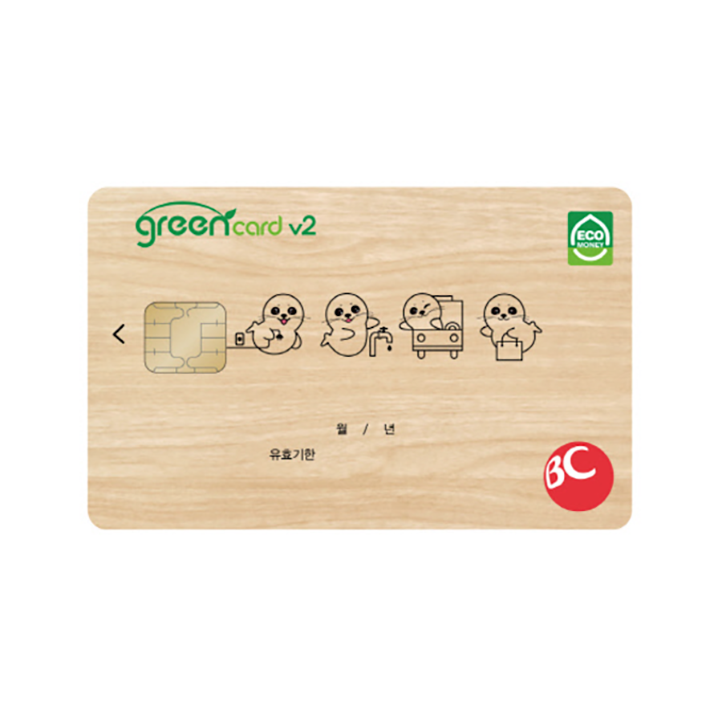


Introduced in 2011 in partnership with the South Korean Ministry of Environment, the Green Card is a credit/cheque card that provides various monetary incentives for users to adopt an eco-friendly lifestyle (Eco Money 2020). The Green Card is offered by a wide range of banks and credit card companies in South Korea. Most Green Cards can only be used domestically, but some providers also offer a Visa/MasterCard option. The second version was launched in 2016, replacing the original plastic card with a wood-based material (Park 2016).
The Challenges
It is often difficult for people to break out of established lifestyle patterns without a clear and immediate incentive. Even if they vaguely understand that their consumer choices have an impact on the environment, few recognise the depth and breadth of their influence as consumers on their surrounding communities. Thus, visuals such as statistics on the pace of climate change or pictures of melting glaciers have had limited effect on people’s willingness to make changes in their own lives. As unsavory as it sounds, monetary incentives have shown some degree of correlation with environment-related behavioural and mindset changes, such as in Lanzini and Thøgersen’s 2014 study. This may be because, as people find themselves drawn to discount opportunities, they also begin to draw the links between environmental protection and their day-to-day purchase decisions.
The Solution
The Green Card provides a monetary incentive for users to adopt an eco-friendly lifestyle and develop appreciation for the environment. First, a Green Card holder may enter into more than 140 national parks and museums free of charge (Harincheo 2020). Second, although users may use the Green Card to pay for any type of expenses, they may accumulate extra ‘Eco Points’ by using the Green Card to buy designated ‘green products’, pay for public transportation, or order secondhand books (Green Card Annae2020; Green Card 2019). A user may even accumulate Eco Points by reducing their household electricity, gas and water consumption (Tanso Mileage2020). Once a certain amount is reached, points accumulated in this way may be used as cash.
The Impact
From its release in July 2011 to the end of August 2015, 17.1 million Green Cards have been issued (Im 2015). In 2016, it was estimated that the use of Green Cards from 2011 to 2016 had contributed to reducing CO2 production by up to 196 tonnes (Park 2016). Banks and credit card companies in partnership with the Green Card have been instrumental in expanding the card’s impact towards different industries. By virtue of such partnerships, Green Card users may now accumulate Eco Points from a total of 52,625major shopping malls, secondhand bookstores, convenience stores, hotels and other service providers across the country (Seon 2020). Users noted that the prospect of accumulating Eco Money through the Green Card has motivated them to buy more products with an eco-friendly label (Unknown 2017; Unknown 2019). As of October 2020, 20 million Green Cards have been issued (Seon 2020).
Reference
Eco Money (2020) [Online]. Available at: http://www.ecomoney.co.kr (Accessed: 12 November 2020). (only available in Korean)
Eco Money (2020). Green Card Annae [그린카드 안내] [Online]. Available at: http://www.ecomoney.co.kr/app/green/html/customer/card/guide.jsp (Accessed: 12 November 2020). (only available in Korean)
Eco Money (2020). Harincheo [할인처] [Online]. Available at: http://www.ecomoney.co.kr/app/green/html/customer/green/publicDetail.jsp (Accessed: 12 November 2020). (only available in Korean)
Eco Money (2020). Tanso Point (Eco Mileage) [탄소포인트 (에코마일리지)] [Online]. Available at: http://www.ecomoney.co.kr/app/green/html/customer/green/cpoint.jsp (Accessed: 12 November 2020). (only available in Korean)
Green Card (2019). YES24 jung-go maejang-eneun Green Card-reul sseuseyo! [YES24 중고매장에는 그린카드를 쓰세요!] [Online] Available at: https://blog.naver.com/thegreencard/221724764490 (Accessed: 12 November 2020). (only available in Korean)
Im, J. (2015). Chinhwangyeong sobi saenghwal bogeub… ‘Green Card'1 cheonmanjang dolpa [친환경 소비생활 확산…’그린카드’ 1 천만장 돌파] [Online]. Yonhap News Agency. Available at: https://www.yna.co.kr/view/AKR20150917068600004?input=1195m (Accessed: 12 November 2020). (only available in Korean)
Lanzini, P. and Thøgersen, J. (2014). ‘Behavioural spillover in the environmental domain: An intervention study’. Journal of Environmental Psychology, 40, pp. 381- 390. Available at: https://www.sciencedirect.com/science/article/abs/pii/S0272494414000887 (Accessed: 12 November 2020).
Park, S. (2016). Chinhwangyeong sobi saenghwal, Green Card V2 chulsi [친환경 소비생활, 그린카드 V2 출시] [Online]. Seoul News. Available at: http://www.seoul.co.kr/news/newsView.php?id=20161124500107&wlog_tag3=naver (Accessed: 12 November 2020). (only available in Korean)
Seon, B. (2020). Chinhwangyeong Green Card 2 cheonmanjang sidae yeollyeossda [친환경 그린카드 2 천만장 시대 열렸다] [Online] Gukto Ilbo. Available at: http://www.ikld.kr/news/articleView.html?idxno=226253 (Accessed: 12 November 2020). (only available in Korean) Unknown (2017).
Nogsaegjepum Green Card-lo gumaehago~ Eco Money point-eu jeoglib badgong~ [녹색제품 그린카드로 구매하고~ 에코머니 포인트 적립 받공~] [Online]. Naver Blog. Available at: https://blog.naver.com/chyung1505/221159955886 (Accessed: 13 November 2020). (only available in Korean)
UID: 3035361570 6 Unknown (2019). Green Card sayonghago Eco Money point jeoglibdo hago jeotansosaenghwal-eul silcheonhabnida. [그린카드 사용하고 에코머니 포인트 적립도 하고 저탄소생활을 실천합니다] [Online]. Naver Blog. Available at: https://blog.naver.com/rudqlsmama/221591488375 (Accessed: 13 November 2020). (only available in Korean)